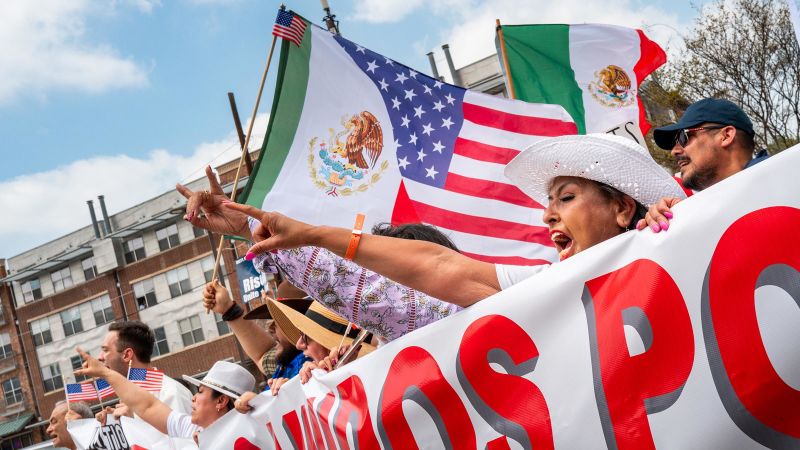
The Trump administration’s escalating efforts to suppress and retaliate against public dissent present a difficult question for noncitizens living in the United States who want to protest the president’s policies. Is it worth becoming a target? Activists and protest organizers say that’s a calculation that millions of people legally living and working in the United States will have to make as public outrage against the administration grows. In Houston on Saturday, several lawyers, lawmakers and organizers hosted an immigration-focused town hall where they explained the constitutional rights that all people have when interacting with law enforcement.
But underlining the routine informational session were warnings of caution for those seeking to protest the issues that affect them most closely. “As organizers who feel compelled to protest in this day, we have to accept we may be subject to removal,” Jaclyn McJunkin, an immigration-rights organizer and activist, told the group of about 50 people. “It’s just something that you have to embrace, OK? Because if you don’t, then they win, right?” For people living in the US illegally, participating in a public protest has long carried the risk of being identified, detained and processed for deportation.

Risk is extended to visa holders, lawful permanent residents and Deferred Action for Childhood Arrivals recipients in the country legally — any interaction with law enforcement could lead to a revocation of their status or other immigration-related consequences. But new, sweeping immigration orders from President Donald Trump ’s administration, along with the detention of nearly a dozen known students and faculty members in the country legally who were involved in pro-Palestinian protests, have exacerbated concerns about any expression of public discontent toward the administration or its policies. Trump has long been angered by protests he disagrees with.
During his first term, the president sicced law enforcement on a peaceful crowd outside the White House protesting George Floyd’s murder in 2020. In the first months of his second term, the president has expanded his efforts to stifle dissent and wield his power against institutions that have angered him, including law firms, educational institutions, museums and performing arts centers. He said last month he would try to stop federal funding for colleges that allowed what he described as “illegal” protests.
Trump has not said what in his view makes a protest “illegal.” “This is something that I’m living every single day,” Cesar Espinosa, a lawful permanent resident who is also the executive director of immigration civil rights organization FIEL Houston, told the Saturday town hall. “I’m in — not fear — but I’m constantly thinking about this, and it’s something that has hit close at home.
” Espinosa added: “I have embraced the fact that there could be consequences, but at the end of the day, they could try to take me away, but they’re not going to take away our spirit.” More than 700 immigration-related demonstrations have taken place in the United States in 2025, according to data and analysis from the non-profit Armed Conflict Location & Event Data and the Bridging Divides Initiative at Princeton University, both of which track protest movements. Hundreds demonstrate in Dallas One march in Dallas on Sunday drew about 1,200 people, according to estimates from the city’s police department.
Protest organizers had hoped for at least 10,000, but said fears about immigration operations might have dampened turnout. “It’s a very unique situation with such a hostile political environment that we’re in now. So I wish we had more people, but the fact of the matter is people are scared,” organizer Domingo Garcia told CNN.
The crowd, which marched from a cathedral in downtown Dallas to City Hall, was encouraged to wear white and carry American flags as a symbol of unity as organizers called for bipartisan immigration reform. Some protesters acknowledged anxiety about attending the march but said the moment required them to speak out. Salvador Arthur Cedillo, a 59-year-old Navy veteran who said the Trump administration’s cuts to the Department of Veterans Affairs inspired him to protest, said the president’s crackdown on dissent is inspiring him to “stand up and let my voice be heard.
” At the front of the march was Democratic Rep. Al Green, who himself is no stranger to dissenting against Trump’s policies. Green, who represents Houston, was kicked out of the president’s joint address to Congress last month after interrupting Trump’s speech to criticize his policies.
Green was later censured by the House of Representatives for his interruption. The city is no stranger to large-scale mobilizations for immigration reform. Hundreds of thousands of people participated in a 2006 march to protest proposed legislation that would have strengthened the penalties for illegal immigration.
The Trump administration’s anti-immigration rhetoric has also become personal for many protesters, including Marbella Carranza, who has said her 11-year-old daughter, Jocelynn, died by suicide after being bullied due to her family’s immigration status. Briefly addressing protesters at the end of the march, Carranza, her voice breaking, told the crowd in Spanish that she’s never marched for a cause before, but said it’s important to fight for immigration reform, especially after “everything my daughter went through.” “I only ask the community to continue fighting, to continue united for this cause and that my daughter’s death not be in vain,” Carranza said.
.








_8.jpg?itok=wp-xhXRB)





